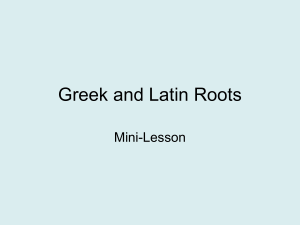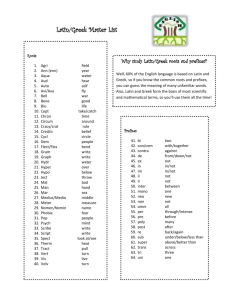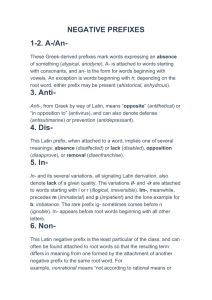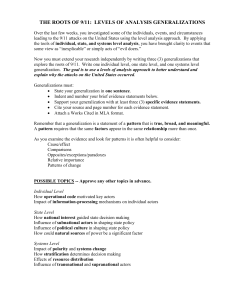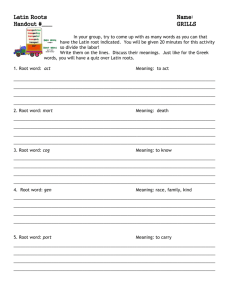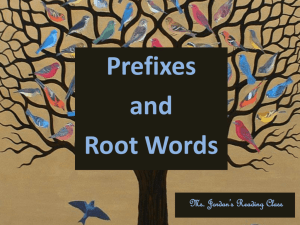Unit 6, Week 3
advertisement
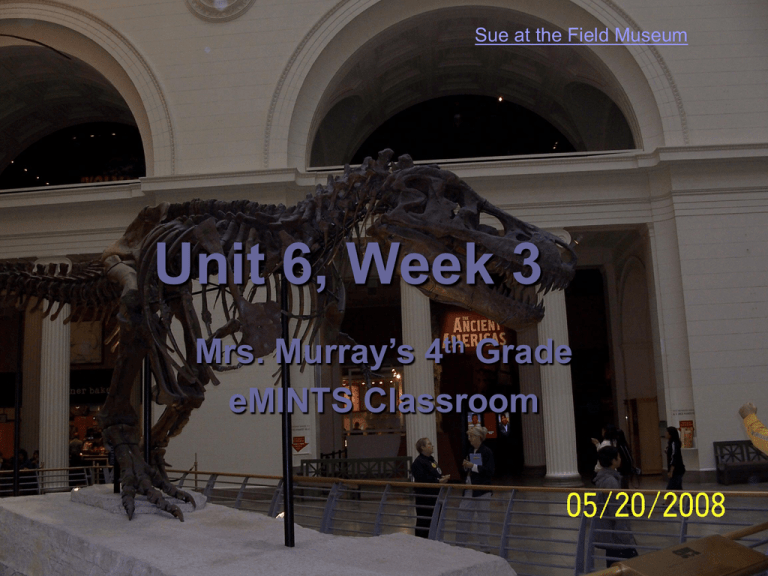
Sue at the Field Museum Unit 6, Week 3 Mrs. Murray’s 4th Grade eMINTS Classroom Vocabulary: paleontologist- a scientist who studies fossils stumbled upon- found by accident fossil- the remains of a plant or animal that lived long ago and was preserved in rocks inspected- looked at closely Practice: Quia...Matching Quia.....Cloze Vocabulary: Story Words specimens- items of a certain type collected for study backbones- bones forming the spinal column of an animal or person professionals- people whose careers involve specialized knowledge biography- a true story about a person’s life, written by someone else Latin Roots- words that are used in English that are made from Latin roots generalization- a broad statement or conclusion functional documents- are documents that have a specific purpose. Newsletters, emails, posters, forms, menus, surveys, flyers, and schedules are all examples of a functional document. Vocabulary: Words in Context paleontologist inspected stumbled upon fossil Last weekend I _____________ a bird’s nest while jogging through the park. I would love to work as a __________ and study fossils. My aunt gave me a _______ to see what kind of animal it was. I closely ___________ the fossil to see what kind of animal it was. Vocabulary: Word Parts Latin Roots Many English words have Latin roots. If a good reader learns the common Latin roots, they will be able to figure out many unfamiliar words. “She inspected the rocky cliffs above her head and saw three dinosaur backbones. spec means to look at, watch, see, aim at, tend towards Vocabulary: Word Parts Latin Roots aud bene cap cide clud, clus dic doc fer form ject hear good, well head kill shut say to teach bear, carry shape throw audio benefit captain insecticide conclusion dictionary document ferry uniform eject Vocabulary: Word Parts Latin Roots miss mob multi ped port tract uni vert vis send move many foot carry draw, pull one turn see missile automobile multicolored pedometer portable tractor unit vertex visit Fluency: Repeated Reading: Punctuation Paying close attention to punctuation will help a good reader use proper intonation and expression. Good readers know what to do when they see periods, commas, question marks, exclamation points, and dashes. Fluency: Repeated Reading: Punctuation Echo Read..... Amber is nature’s time capsule. It forms a tight seal around whatever is trapped inside, protecting it from the effects of aging. Scientists have found insects preserved in amber that come from the time of the dinosaurs. Online Leveled Stories: Read or/and Listen Phonics: Prefixes A prefix is a group of letters added to a word to make a new word. Recognizing common prefixes can help good readers decode words and understand their meanings. Some common prefixes that change the meaning of a word to its opposite are: dis, non, un Each of these has a short vowel sound. Prefixes Phonics: Prefixes Practice: Prefix Practice Practice With Prefixes Prefix Under Construction Practice Prefix and Suffix Practice Prefix Matching Build a Tower: Prefix Game Comprehension: Make Generalizations A generalization is a broad statement or conclusion. In nonfiction text, good readers should look for statements in which the author makes a general point based on specific facts or evidence. Good readers should then use the facts presented and their own knowledge to decide whether the generalization is valid or faulty. If a valid generalization is found in a piece of nonfiction work, good readers should also make sure all the facts support the broad statement made. Comprehension: Make Generalizations Generalization: All paleontologists also dive for sunken ships. True or not true? _________ Why? Generalization: Paleontologists need to be adventurous, curious, and patient. True or not true? ____________ Why? Making Generalizations in English Comprehension: Research Study Skill: Functional Documents Good readers can interpret details from functional documents for a specific purpose. For example: We can find information in many sources—articles like “Amber: Nature’s Time Capsule,” newsletters, posters, forms, emails, menus, surveys, schedules, brochures....... Make Your Own Form Comprehension: Cause and Effect When an author’s purpose is to explain how or why certain things happen, he or she often describes causes and their effects. As you read the story, you should look for events that cause actions to happen. Ask yourself, “What happens because of that event?” or “What brought about the action?” Look for signal words and phrases that the author uses to signal cause and effect. Such words include but are not limited to; because, due to, as a result, since, and therefore. TEACHING CAUSE AND EFFECT CAUSE and EFFECT Lesson Comprehension: Cause and Effect Quiz Using signal words Cause and Effect Relationships Cause and Effect Article and Graphic Organizer Cause and Effect Matching Activity Cause and Effect Lesson and Quiz Reflection: Day 1 Choose one of the stations you visited today. Write a summary about what you learned at that station. Reflection: Day 2 Generalizations are broad statements or conclusions. A valid generalization is supported by facts. After reading “Amber: Nature’s Time Capsule,” make a generalization about the article. List two facts that support your generalization. Reflection: Day 3 Given the fact that Sue works underwater as well as digging in rocks, what generalization can you make about her approach to her work? Use information from the article to support your answer. Reflection: Day 4 The Latin root extrem- means “being the most outside.” How does this help you figure out the meaning of the English word extreme? Reflection: Day 5 What effect did discovering the dinosaur fossil have on Sue Hendrickson’s career as a paleontologist? Use information from the story to support your answer.

